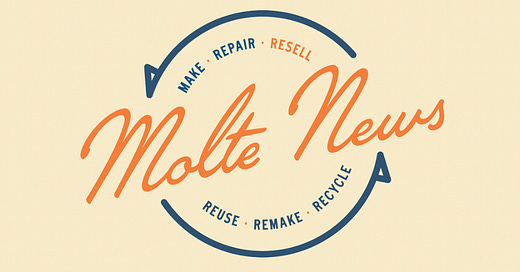This week I will continue with my reflections on our most recent podcast on the topic of creative reuse and remanufacturing. Have a listen if you want to hear more about our guests businesses.
Listen here: Spotify Apple
Zero Waste Daniel (ZWD) is a clothing manufacturing business that produces unique pieces from factory scraps. New York Heartwoods uses fallen trees from specific locations to make heritage quality furniture.
Both companies are taking some thing previously viewed as waste and using it as their input to create valuable products. Megan from New York Heartwoods explained that many downed trees, especially those from a large storm, end up becoming wood chips or even can end up in the landfill, which is mind-boggling to me. I had wrongfully assumed that fallen trees would universally be used for their lumber or at the very least used for firewood.
In retrospect, knowing what I know about clothing manufacturing and reuse, it is always more challenging to process something one by one (like a fallen tree). Our systems in the linear economy are set up to process hundreds and thousands of the same item. When you ask the system to process one unique item at a time, the answer is usually no or not easily. I can extrapolate this to the lumber industry where I’m assuming they have a gigantic, efficient operation that works cohesively to fell thousands of trees from the same area at the same time. That system knows how to process all of these similar type items when it is set up for that single event, but, when you have 5 trees in someone’s backyard and 11 trees from the local park and 8 trees blocking roads, etc., it’s very easy to grasp how these trees may end up as the lowest common denominator product, wood chips. They need to be taken from whatever random location they are in, which is a logistical challenge; transporting trees (large, unwieldy objects) is not easy. Turning them into wood chips is a way to process them where they fell and quickly transform them into a sellable and easily transported product. While wood chips and probably sawdust are the lowest value products to come from trees, at least they are better than landfill.
The parallels with unwanted textiles are clear. Most unwanted textiles end up in landfill, at least currently, with some pre-consumer and post-consumer textiles being sorted out for reuse, recycling and downcycling. When a textile is deemed non-reusable, it will very likely be shredded and turned into insulation or an insulation type product, which in my mind is the same level of product as wood chips or sawdust: better than the landfill, but still, but could be much better. It comes down to those same issues I described with the trees, except clothing is much easier to transport and deal with given its small size and mostly soft materiality. I find a striking similarity in the idea that it feels random where the unwanted trees or the unwanted textiles are coming from. (On second thought, this apparent randomness is probably easily mapped and predicted based on storm patterns, textiles in the wastestream, etc., a topic for another day.)
This is one of the challenges of the circular economy: how do we efficiently collect reusable inputs from anywhere and everywhere in unknown quantities? How do we make that process efficient so that we can get the value out of that would-be-waste?
In NY Heartwoods’ case, they are not offering a mass solution to deal with all of the felled trees from a certain region, but they are offering a custom solution for certain trees felled on certain properties where they create some thing of extremely high value out of those trees.
Similarly, ZWD is using fabric scrap from factory cutting rooms, something that has been viewed as waste and still is in many places. Recently, textile scrap’s profile as a valuable input is rising due to its ability to serve as a clean feedstock for textile recycling. (Something I dove into in this newsletter.)
ZWD is taking these scraps that factories would otherwise likely be throwing away, and they are piecing them together to create unique clothing clearly made from scraps. Like NY Heartwoods furniture, these scrap-based clothes are highly artistic and unique. Although they offer basic items, like sweatshirts and sweatpants, the amount of work that has gone into each one is plainly visible. I would argue most people know enough about making clothes that when you see hundreds of seams attaching small pieces of fabric in a single piece of clothing, you can imagine that took a while to make, you can perceive a higher degree of complexity.
Mission Driven Businesses
Lastly, what struck me about both of these founders is how mission driven they are. Their businesses are an extension of themselves and their beliefs. This is always compelling, and I love to see an increase of these types of businesses because it means more people are living authentically in tandem with their business. That is absolutely something I am striving for every day and feel privileged and proud to have a business, my business, that is meaningful to me and my beliefs.
Quick Question/Poll
I’m considering recording this as a short weekly podcast. I’m curious if you would prefer to read this weekly or listen to it as part of your podcast feed?
See you soon you big baboon!
Cynthia
cynthia@moltevolte.com






Amazing article! Such unique concepts !